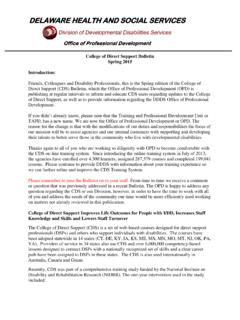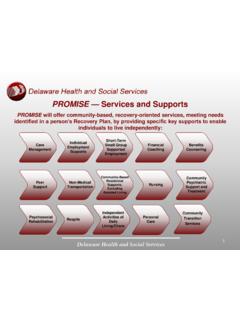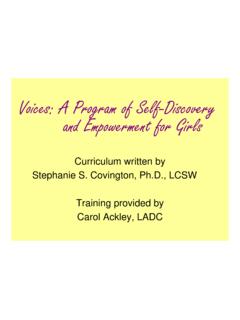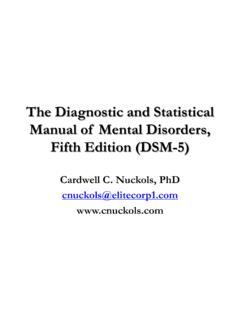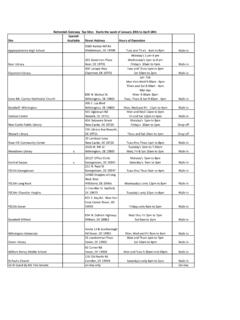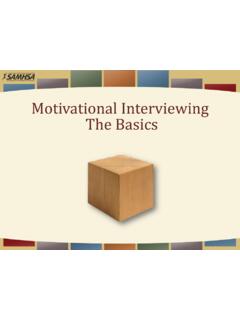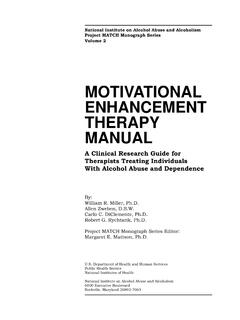Transcription of Skill-Building in Treatment Plans that Make Sense to Clients
1 Skill-Building in Treatment Plans that Make Sense to Clients David Mee-Lee, in Treatment Plans that Make Sense to ClientsDavid Mee-Lee, , CA(530) 753-4300; Voice Mail (916) 29, 2009 Newark, DE A. Person-Centered Service and Treatment Planning Consider the following:1)What is a Treatment plan, and why use one?a)NOT just a written plan on paperb)Most important with the most complex clientsc)Should represent a shared vision2)Teamworka)The client is the most important team memberb)The client is the person who should know the Treatment plan the bestc)Includes productive work with each other, especially across agencies3)Engagementa)Do we view the world through the client s eyes?
2 B)What does the client want most that drives the Treatment plan?c)How can we help the client to be utilizing his/her strengths?d)How do WE feel if the focus is only on the negative desires, hopes and goals are critical1. Individualized TreatmentA diagnosis is a necessary, but not sufficient determinant of Treatment . A patient is matched to services based on clinical severity, not placed in a set program based only on having met diagnostic criteria. PARTICIPANT ASSESSMENTData from allBIOPSYCHOSOCIALD imensionsPROGRESSPROBLEMS or PRIORITIEST reatment Response:Build engagement and alliance working Clinical functioning,psychological, with multidimensional obstacles inhibitingsocial/interpersonal LOFthe client from getting what they want.
3 Proximal Outcomes , SessionWhat will client do? Rating Scale; Outcome Rating ScalePLANBIOPSYCHOSOCIAL TreatmentIntensity of Service (IS) - Modalities and Levels of Service_____1 Skill-Building in Treatment Plans that Make Sense to Clients David Mee-Lee, Multidimensional AssessmentBecause mental and substance-related disorders are biopsychosocial disorders in etiology, expression and Treatment , assessment must be comprehensive and multidimensional to plan effective care. The common language of the six assessment dimensions of the ASAM Patient Placement Criteria can be used to determine multidimensional assessment of severity and level of function of addiction intoxication and/or withdrawal potential conditions and complications conditions and to Change 5.
4 Relapse/Continued Use/Continued Problem potential6. Recovery environmentORThe six LOCUS dimensions are used to determine clinical severity to identify needs and Risk of StatusIII. Medical, Addictive and Psychiatric Co-MorbidityIV. Recovery Environment A. Level of Stress B. Level of SupportV. Treatment and Recovery HistoryVI. Engagement Assessment DimensionsAssessment and Treatment Planning Focus1. Acute Intoxication and/or Withdrawal PotentialAssessment for intoxication and/or withdrawal management. Detoxification in a variety of levels of care and preparation for continued addiction services2. Biomedical Conditions and ComplicationsAssess and treat co-occurring physical health conditions or complications.
5 Treatment provided within the level of care or through coordination of physical health services3. Emotional, Behavioral or Cognitive Conditions and ComplicationsAssess and treat co-occurring diagnostic or sub-diagnostic mental health conditions or complications. Treatment provided within the level of care or through coordination of mental health services 4. Readiness to ChangeAssess stage of readiness to change. If not ready to commit to full recovery, engage into Treatment using motivational enhancement strategies. If ready for recovery, consolidate and expand action for change5. Relapse, Continued Use or Continued Problem PotentialAssess readiness for relapse prevention services and teach where appropriate. If still at early stages of change, focus on raising consciousness of consequences of continued use or continued problems as part of motivational enhancement strategies.
6 6. Recovery EnvironmentAssess need for specific individualized family or significant other, housing, financial, vocational, educational, legal, transportation, childcare services3. Correlation Between ASAM PPC-2R and the LOCUSASAM DimensionsLOCUS Evaluation Parameters1. Acute Intoxication and/or Withdrawal PotentialI. Risk of HarmIII. Medical, Addictive Co-Morbidity2. Biomedical Conditions and ComplicationsIII. Medical, Addictive Co-Morbidity3. Emotional/Behavioral/Cognitive Conditions and ComplicationsI. Risk of HarmIII. Psychiatric Co-Morbidity4. Readiness to ChangeVI. Engagement5. Relapse/Continued Use/Continued Problem PotentialV. Treatment and Recovery History6. Recovery EnvironmentIV A. Level of StressIV B. Level of Support_____2 Skill-Building in Treatment Plans that Make Sense to Clients David Mee-Lee, Biopsychosocial Treatment - Overview: 5 M s* Motivate - Dimension 4 issues; engagement and alliance building* Manage - the family, significant others, work/school, legal* Medication - detox; HIV/AIDS; anti-craving anti-addiction meds; disulfiram, methadone; buprenorphine, naltrexone, acamprosate, psychotropic medication * Meetings - AA, NA, Al-Anon; Smart Recovery, Dual Recovery Anonymous, etc.
7 * Monitor - continuity of care; relapse prevention; family and significant others5. Treatment Levels of ServiceI Outpatient Services II Intensive Outpatient/Partial Hospitalization ServicesIII Residential/Inpatient Services IV Medically-Managed Intensive Inpatient Services 6. How to Target and Focus Treatment Priorities What Does the Client Want? Why Now?Does client have immediate needs due to imminent risk in any of the six assessment dimensions? Conduct multidimensional assessmentWhat are the multiaxial DSM IV diagnoses?Multidimensional Severity /LOF ProfileIdentify which assessment dimensions are currently most important to determine Tx prioritiesChoose a specific focus and target for each priority dimensionWhat specific services are needed for each dimension?
8 What dose or intensity of these services is needed for each dimension?Where can these services be provided, in the leastintensive, but safe level of care or site of care? What is the progress of the Treatment plan and placement decision; outcomes measurement?_____3 Skill-Building in Treatment Plans that Make Sense to Clients David Mee-Lee, Client-Directed, Outcome Informed Approach - Common Curative Elements Central to All Forms of Therapy (Despite theoretical orientation, mode, or dosage) Miller, Duncan, and Hubble have attempted to describe a transtheoretical perspective of what accounts for how Clients change, and once knowing this, what therapists can do to enhance the change process.
9 (Miller, Scott D, Duncan, Barry L, Hubble, Mark A (1997): Escape from Babel Toward Unifying Language for Psychotherapy Practice WW Norton & Company)Hubble MA, Duncan BL, Miller SD (Eds) (1999): The Heart and Soul of Change: What Works in Therapy American Psychological Association. Washington, BL, Miller SD (2000): The Heroic Client: Doing Client-Directed, Outcome-Informed Therapy Jossey-Bass Inc. San Client and Extratherapeutic factors: accounts for 40% of the change in therapy. Listen for and validate client change wherever and for whatever reason it initially occurs during Treatment process. Pretreatment change : (change that occurs between first call to schedule and first appointment) - 60% of Clients report pretreatment change Between session change : Improvement between sessions is the rule rather than the exception.
10 - 70% report complaint related improvement between sessions. - The largest percentage of change occurs early in therapy (within the first 1-7 sessions). Potentiating change for the future : - Clients need to see change is a consequence of their own efforts ( positive blame ) 2. Therapeutic Relationship Factors: accounts for 30% of the change in therapy. The role of accurate empathy, respect or warmth and therapeutic genuineness Build a strong therapeutic relationship, which emphasizes partnership or collaboration in achieving goals Treatment should accommodate the client s motivational level or state of readiness for change Treatment should accommodate the client's goals for therapy Treatment should accommodate the client s view of the therapeutic relationship - The client s definition and rating of warmth, empathy, respect, genuineness and validation yields stronger predictions of positive outcome than the therapist s ratings 3.


